The Concept of Sailing Regimes
Basis of the idea of different regimes
I first came across the idea of a set of regimes dependant on wind strength in a book by Walker written in the 1960’s. He based the regime limits on the relative power of the sails to produce side force to windward as against the ability of the rudder and keel to resist it. It was a difficult description but set the stage. The next serious look at splitting the range of wind strengths was Frank Bethwaite’s wonderful “Wings on Water” series. He used a combination of wind speeds and boat stability to define his regimes.
In model boats both these ideas come into play.
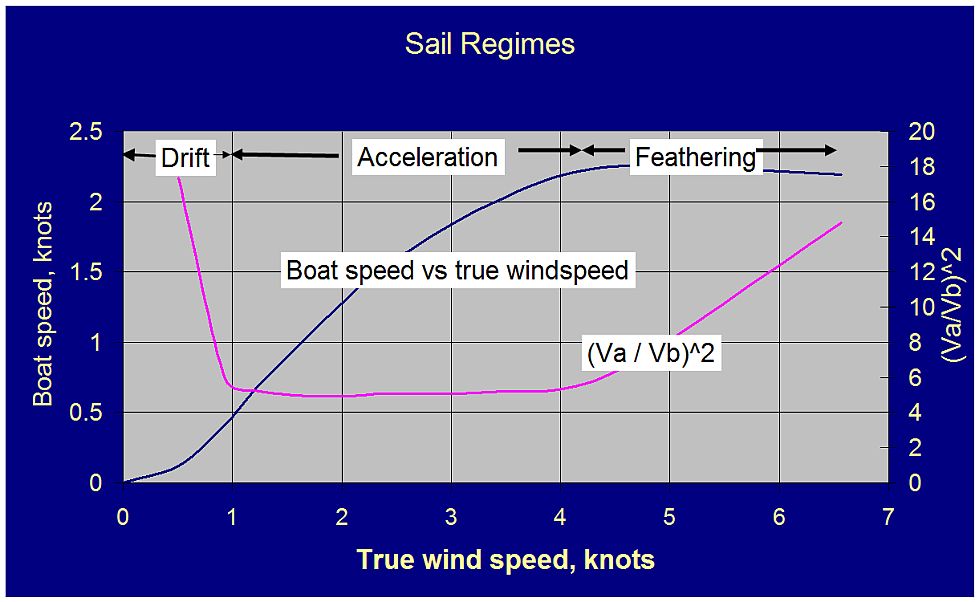
The blue curve in the figure shows the approximate boat speed attained by an IOM with an A rig in flattish water versus the wind speed at the centre of area of the sails: note that up on the bank the wind speed would be 50% to 100% higher.
Now the sail side force is proportional to the square of the wind speed and the maximum force that can be generated by the keel and rudder to resist this side force is proportional to the square of the boat speed. Thus the ratio of (wind speed speed/boatspeed) squared indicates the relative “power” of the sails as compared to that of the keel and rudder. The pink curve shows this ratio, so where this is small, the keel and rudder are more powerful than the sails and vice versa. From the shape of the curve, it is evident that different factors are at work at different wind strengths.
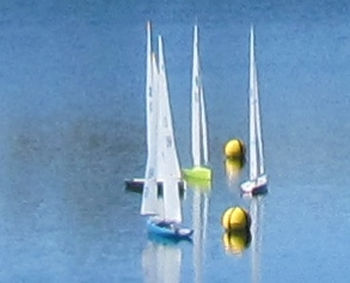 In the drift regime, both the wind strength and the boat speed is low. Also in these conditions the gust to average wind ratios are high (a half a knot to 1.5 knots is a 9 fold force increase!). Lift/drag ratios are also poor, which results in the boat speed being relatively small compared to the wind speed. What this means is that it is easy to overload the keel and rudder because they are moving very slowly through the water so they have little capacity to generate side force and when a gust hits, acceleration will be sluggish. Traditional wisdom is that in this regime flat, heavily twisted sails are what is required in what are usually glassy conditions. The reason is a perception that a flat plate is the best shape in very light airs (think butterflies), and in such conditions there is usually a steep change in wind speed with height starting from zero at the water surface. It is possible, however, for such light winds to be turbulent if the pond surrounds disturb the airflow and this may ruffle the water surface: in this instance less twist and fuller sails can be better. In either case sailing for boat speed rather than pointing is the way to go.
In the drift regime, both the wind strength and the boat speed is low. Also in these conditions the gust to average wind ratios are high (a half a knot to 1.5 knots is a 9 fold force increase!). Lift/drag ratios are also poor, which results in the boat speed being relatively small compared to the wind speed. What this means is that it is easy to overload the keel and rudder because they are moving very slowly through the water so they have little capacity to generate side force and when a gust hits, acceleration will be sluggish. Traditional wisdom is that in this regime flat, heavily twisted sails are what is required in what are usually glassy conditions. The reason is a perception that a flat plate is the best shape in very light airs (think butterflies), and in such conditions there is usually a steep change in wind speed with height starting from zero at the water surface. It is possible, however, for such light winds to be turbulent if the pond surrounds disturb the airflow and this may ruffle the water surface: in this instance less twist and fuller sails can be better. In either case sailing for boat speed rather than pointing is the way to go.
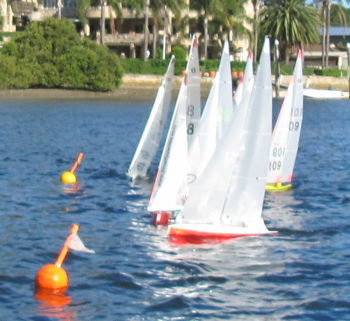 In the acceleration regime all this changes. The acceleration regime begins as the wind becomes stronger: an indication is the development of a small stern wave. Lift to drag ratios increase and the boat speed climbs relative to the wind speed. In this regime too, the gust to average wind ratio tends to decrease. In this regime the hydrofoils can easily develop the necessary side force so the increase in side force as a gust hits can be accommodated without an excessive leeway. As the boat accelerates the leeway will decrease again. In this regime, most boats will sail themselves. Even boats with the keel a bit too far aft and carrying lee helm or boats with small keels may sail reasonably because the high side force capacity of the keel will mask these defects. In this regime the keel and rudder can easily cope with any side forces from the sails, so the boat can point high and have powerful sails. The top of this regime is reached when the boat is approaching hull speed, or rather when any increase in speed requires a disproportionate increase in driving force, coupled with excess heeling.
In the acceleration regime all this changes. The acceleration regime begins as the wind becomes stronger: an indication is the development of a small stern wave. Lift to drag ratios increase and the boat speed climbs relative to the wind speed. In this regime too, the gust to average wind ratio tends to decrease. In this regime the hydrofoils can easily develop the necessary side force so the increase in side force as a gust hits can be accommodated without an excessive leeway. As the boat accelerates the leeway will decrease again. In this regime, most boats will sail themselves. Even boats with the keel a bit too far aft and carrying lee helm or boats with small keels may sail reasonably because the high side force capacity of the keel will mask these defects. In this regime the keel and rudder can easily cope with any side forces from the sails, so the boat can point high and have powerful sails. The top of this regime is reached when the boat is approaching hull speed, or rather when any increase in speed requires a disproportionate increase in driving force, coupled with excess heeling.
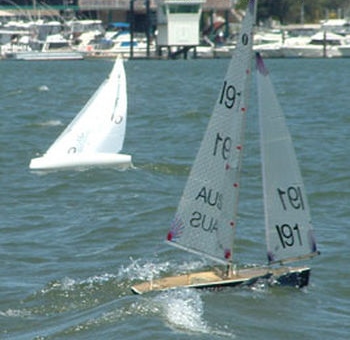 The feathering regime begins after the acceleration regime ends. When this happens,
The feathering regime begins after the acceleration regime ends. When this happens,
gusts can produce major increases in side force, heeling the boat and loading up the hydrofoils with no hope of increased boat speed to help compensate. The result is increased leeway and weather helm. The situation is exacerbated with waves because they can easily double the hull resistance, slowing the boat and further reducing the ability of the hydrofoils to produce side force. This regime will show a marked decrease in performance of a boat with an undersized keel, and if the boat still carries lee helm in these conditions it will suffer severely. The boat may well become sluggish, staggering in the gusts and generally slowing. In this regime, sails need to be flattened and high pointing is not feasible.
This, then is the general idea of regimes. The boundaries for B and C Rigs are determined by similar factors, though the wind speeds and boat speeds will differ. Of course subdivisions can and have been made based on such things as gust onslaught rates, gust/lull ratios, waves etc, especially their impact on boat handling, but all that is beyond this short article.
Colin Thorne
September 2009 rev June 2013
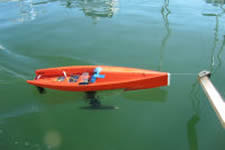
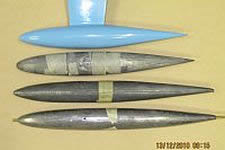
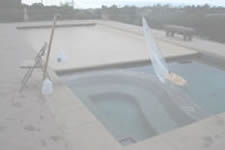
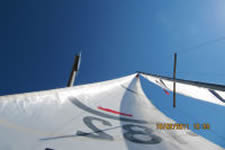
 Behaviour
Behaviour